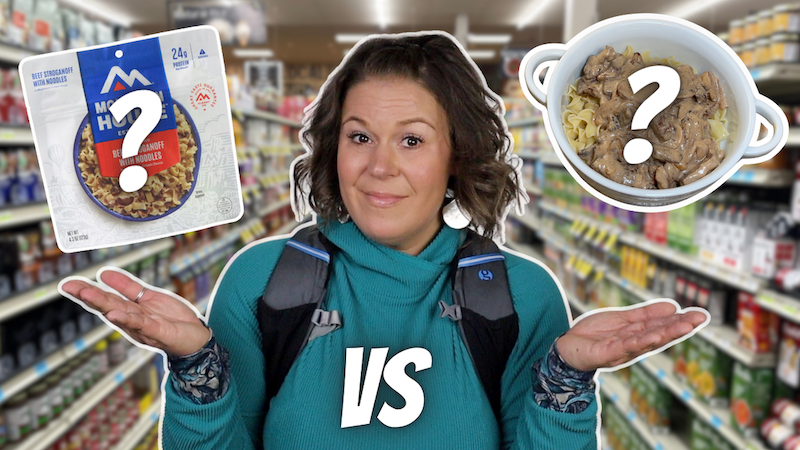
Are you tired of buying expensive pre-packaged backpacking meals for all of your outdoor adventures? What if you could turn some of those store bought meals into your own backpacking meals at home for a fraction of the cost for your next trip?
I spent a lot of money on pre-packaged freeze-dried backpacking meals last year. While these meals are super convenient and can be really yummy, they’re also expensive and not always all that healthy.
My 2025 Winter Food Prepping Project
This winter, I’ve been busy preparing all my meals for the upcoming backpacking season.
Each week, I take the leftovers from the meals I cook at home, put them in either the food dehydrator or freeze dryer and then package them up into individual serving sizes, making them trail-friendly meals I’ll get to enjoy on all of my upcoming backpacking trips this year.
Want to start making your own backpacking meals? I promise, it’s not as hard as you might think it might be. It’s quite easy and can end up saving you some serious money in the long run.
So, let’s talk about what the benefits are to making your own backpacking meals, the different ways you can prepare your own backpacking food and what the upfront costs are for making your own backpacking food at home.
Benefits to Making Your Own Backpacking Meals
Cost Savings
Making your own backpacking meals at home can be much more affordable than buying pre-packaged backpacking meals. You can purchase ingredients in bulk and create meals for a fraction of the cost, making it easier to stick to a budget while still getting to eat well out in the backcountry.
Ingredient Control
When you make your own backpacking meals, you have full control over the ingredients. This means you can avoid preservatives, artificial flavors and allergens that may be present in store-bought options. You can also tailor your meals to suit specific dietary preferences or restrictions.
Bring Your Favorite Meals Outdoors
Making your own backpacking meals allows you to recreate the flavors and dishes you love eating at home. Instead of settling on bland or boring food while out on the trail, you can enjoy familiar comfort foods while you’re out in the backcountry.
It’s Fun and Creative
Preparing your own backpacking meals can also be a fun way to get creative in the kitchen. You get to experiment with different flavors, textures and cooking techniques. Plus, it can help make trip planning more fun and you can take pride in all of the meals you create.
Different Ways to Prepare Your Own Backpacking Meals
There’s lots of different ways you can prepare your own backpacking food.
There’s low prep/no cook grocery store meal options like cheese, salami and crackers, single serving tuna or chicken packets, protein bars, DIY smoothies and meal replacement shakes, and you can basically put anything on a tortilla.
There are grocery store backpacking meal options that require cooking like instant oatmeal, dehydrated beans with instant rice, instant mashed potatoes or stuffing, ramen packets and soup mixes.
There’s cold soaking which is a method of preparing food out in the backcountry without a stove by soaking dehydrated food in cold water.
There’s also the option for subscription-based DIY backpacking meal recipe databases like Backcountry Foodie and Chef Corso/Outdoor Eats if you’re looking for guidance with trying to figure out DIY meal and snack options.
And, if you’re interested in turning some of the meals you cook at home into backpacking meals, there’s always the option to either dehydrate or freeze-dry your own backpacking food.
If you’re trying to decide which DIY food prep process will work best for you when preparing your own backpacking meals, check out this post where I explain the differences between freeze-dried and dehydrated backpacking food.
Upfront Costs for Making Your Own Backpacking Meals
When making your own backpacking meals, there are a few upfront costs to consider:
Ingredients for each recipe: The cost of ingredients will depend on the specific recipes you’re preparing. High-quality ingredients can add up, especially if you’re purchasing in bulk for multiple meals. However, buying ingredients in larger quantities can often help reduce the cost per meal in the long run.
A Food Dehydrator: While a food dehydrator can be a bit of an investment upfront, they are usually affordable, with basic models starting around $50-$150. If you plan on making dehydrated meals often, this can be a cost-effective option compared to purchasing pre-packaged meals.
A Freeze Dryer: Freeze dryers are generally more expensive than a food dehydrator, ranging from $1,500 to $4,000 or more, depending on the size and brand. If you’re planning to make large quantities of freeze-dried meals for extended trips or want to share with others, this might be an investment worth considering.
A Vacuum Sealer: A vacuum sealer is essential for storing your meals in airtight packaging, which helps preserve freshness and reduces the risk of spoilage. These typically cost between $40 and $200, depending on the brand and features. It’s a useful investment if you plan on prepping large quantities of meals.
Food Storage Options: You’ll also need appropriate containers to store and cook your backpacking meals in. Ziploc freezer bags and Mylar bags are commonly used, with Mylar bags offering a better long-term storage option due to their ability to block light and oxygen. Reusable food-safe containers can also be used if you prefer an eco-friendly alternative. These storage options range in cost from a few dollars for Ziploc bags to $20 or more for Mylar bags and higher-quality containers.
Before spending any money on any of the upfront costs needed for making your own backpacking meals, make sure you take into consideration:
Frequency of Backpacking Trips
The frequency of backpacking trips you’ll be going on. The more often you go backpacking, the more worthwhile these investments will become. If you plan on taking several trips a year, the upfront costs of purchasing tools like a dehydrator, freeze dryer or vacuum sealer will pay off over time.
Meal Quantity
Consider how many meals you’ll need for each trip and how many trips you plan on going on. Preparing meals in bulk for multiple trips can help you save money and time in the long run.
Budget & Time Commitment
Think about your budget and how much time you’re willing to invest in meal prep for your backpacking trips. Dehydrating or freeze-drying meals can take several hours, depending on the quantity of meals you’re preparing, so it’s important to decide if you’re ready to make the necessary time commitment to prep your own backpacking meals.
Even with the upfront costs for preparing your own backpacking meals, these expenses can be balanced based on how often you go backpacking, how much time and effort you want to put into meal prepping for your trips, and your overall budget. The key is finding the right combination of equipment and ingredients that suits your budget, backpacking needs and hiking lifestyle.
DISCLAIMER: This post and video contain affiliate links, which means that if you click on one of the product links, I’ll receive a small commission at no extra cost to you. This helps support my blog, The Hungry Hiker and allows me to continue to create content for you free of charge. Thank you for your support!
